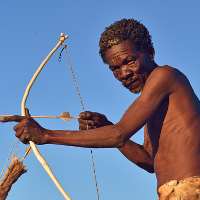The Namaqualand Flowers
In the Namaqualand, spring comes with a burst of flowers that become an attraction each year. The flowers come to life at the beginning of September and transform the dry, parched land into a beautiful flower show. The province experiences 50 millimetres of rain each year which aids in the blooming of the flowers from the end of August until mid- September. They lay a carpet of a range of flora on the horizon of the dry landscape. The Namaqualand boasts 3,500 plant species of which 1,000 cannot be found anywhere else in the world. During this blooming period the Namaqua Flower Skilpad Camp offers accommodation among nature’s confetti. To view the flowers from a different angle, the Oorlogskloof nature reserve offers trail hiking and you can see the flowers from one of the reserve’s high point lookouts.
Nature Lovers
The Augrabies Fall National Park was established in 1966, and is located around the Augrabies waterfall. The waterfall is 60 metres high, while the gorge below it is 240 metres wide and runs for 18 kilometres. The park offers good hiking trails with the opportunity to view all the wonders of the area. To complete your day, a walk up to the Moon rock will give you a bird’s eye view of the park. The Richtersveld Transfrontier Park is the driest part of South Africa. It is also the best place for independent sightseeing, with 4×4 and walk trails as well as the option to paddle down the Orange River. The park is home to the black-backed jackal, leopard, Hartmann’s zebra, duiker, klipspringer and rock hyrax. The rock hyrax is an attraction of its own, as they are a favourite prey of Verreaux’s eagle that can be seen hovering over the area.
Museums
In the town of Kimberley, bookworms can indulge at the Sol Plaatje House Museum that has a library for African literature. Sol Plaatje authored many important documents and books such as Native Life in South Africa. The Africana Library opened its doors as the Kimberley Public Library in 1887 and was converted into the Africana Research Library in 1984. The library is home to about 14,000 books, 640 manuscripts and 12,000 photographs. Collections include early printed editions of African indigenous languages such as San, Setswana, isiZulu and isiXhosa. There are also books on the 1870s diamond rush, newspapers from the 1870s, books by early European travellers and maps from the South African War. The Kimberley Mine museum will take you on the tour of the town before the diamond rush that led to the famous Kimberley hole, which spans 17 hectares.
San Heritage
The Northern Cape was home to the likes of Kgosi Galeshewe and Sol Plaatje. Chief Galeshewe was born in 1840, and led his soldiers into battle in 1878 against the oppressive rule of the time. His bravery was inspired by his love and respect for his people in the area now named after him in Kimberley. Sol Plaatje was also born in the Northern Cape in 1876 – he wrote Mhudi in 1919, the first English novel written by a black person. Plaatje also translated Shakespeare’s work into Setswana, and is known for his contribution to South African politics. The Kalahari is home to the San (Bushmen) people. The Khomani San are also found in the Kalahari and are one of 14 known remaining ancestral population said to be to whom all modern-day humans genetically relate. Their culture stretches back over 20,000 years, while their genetic origins go as far back as one million years. The Khomani San are also the only remaining indigenous San of South Africa. The San people are known for staying true to their traditional practices of hunting and storing food, traditional dances, storytelling and rock painting. You can enjoy hunting with a bow and arrow, see the bush school, and hear old folk stories from the villagers. There’s also an opportunity to see the bush school Oupa Dawid Kruiper built to ensure that indigenous knowledge and skills were transferred to the younger generations. The pupils at the school are still taught in the traditional manner.
Orange River water activities
The Orange River starts in the Lesotho Drakensberg Mountains and ends near Northern Cape’s border with Namibia. As it passes through the province it makes for great activities in the dry surrounds. The Orange Gorge canoe trip down the river is a sure way to experience the river’s magnificence, see the province’s wilderness and view the second largest waterfall of the Orange River; the Ritchie Falls is only accessible by river. If you prefer a more relaxed way of exploring the river, the Khamkirri boat cruise is a great option. You can watch the sun setting on the water, while dining on the river. Hot air balloons are never a disappointment when it comes to a bird’s eye view. Hot Air Ballooning SA takes you on a journey on the lower valley of the river. The tour takes in the livelihood of the vineyards along the thirsty landscape of Augrabies. This is the best way to close your tour of the Northern Cape province and its wonders.

